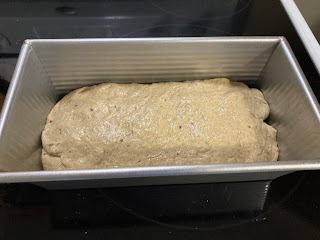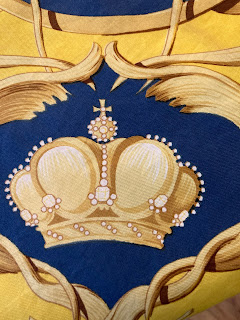For a first attempt at rye bread making, we chose the recipe from King Arthur Flour for "Classic Rye Sandwich Bread".
It calls for:
Ingredients
- 1 1/2 cups (159g) medium rye flour
- 1 3/4 cups (210g) King Arthur Unbleached Bread Flour
- 1 teaspoon (6g) salt
- 2 teaspoons caraway seeds - optional
- 1 tablespoon minced dried onions - optional
- 2 teaspoons instant yeast
- 1 cup (227g) water, lukewarm (105°F to 115°F)
- 1 tablespoon (22g) molasses or honey
- 1 1/2 tablespoons (22g) unsalted butter, melted
We are not fond of the crunch of seeds in our bread, so I omitted that, and since we had no dried onions, we omitted that, too. I used dark molasses for the sweetener.
It appears that this should have proofed longer. It is heavy and dense.
Notice there was no "oven spring".
It reminds us of those little square rye breads that were so popular in the 50s and 60s for hors d'œuvres.
If that's what you're thinking of, it was very good.
However it had no rye flavor.
I think it was definitely missing the caraway seeds.
~
Second Attempt
Using the same recipe, I made some changes.
I made a preferment the night before with 50 grams water and 50 grams rye and a bit of yeast.
A while ago, we got a new coffee grinder, so the old one became a spice grinder. I ground up some caraway seeds and added two teaspoons of caraway seeds which I had ground up, giving it the flavor but less of the crunch of seeds.
That was left, covered, to rest overnight.
What is a preferment, you might ask?
What is a preferment?
Unlike a “straight dough,” in which all of the ingredients for the final dough are combined at once, bread made with a preferment is mixed in two stages: A small portion of the dough is prepared in advance—usually 6–16 hours—and allowed to ferment; then, once it’s bubbly and full of yeast, acid, and bacteria, it’s incorporated with the remaining ingredients—flour, water, salt, and, sometimes, more yeast. The dough then has its bulk rise, where it grows in a bowl or container, before it’s shaped (into buns, breadsticks, loaves, what have you) and left to proof once more.
I had to laugh. In looking this up,
I realized that it is not a very French "pray-fair-mahnt".
It's a pre-ferment. Funny!
When the preferment was combined with the rest of the ingredients, it made a very sticky dough.
I knead using the stand mixer, and this got a 10 minute rest, 10 minute kneading, 10 minute rest, and again a 10 minute kneading.
(The Cuisinart stand mixer has been a workhorse. I bought the first one in 2009, at a time when Kitchen Aid had changed to plastic gears and was getting poor reviews. I bought another one in 2017 when we were living in two houses, and I needed one in each. So now I have the one in the kitchen and a back-up for just in case. Makes me feel very secure!)
I also added a tablespoon of cider vinegar to the dough, since the first recipe wasn't as tangy as expected.
After the first rise, it was shaped and put into the pan:
Looks like this may have been over-proofed. We'll see.
"

It did collapse a bit in the oven.
It is really delicious. Light, tangy, full of caraway flavor without the crunch.
It is more the texture of a sandwich bread.
It also has a tender crust.
It does not have the rubbery texture of deli bread though.
But since it was really delicious, we may just buy deli bread if we want rubbery.
R suggested using
Nina-in-the-Kitchen recipe. I did a quick spreadsheet, and they are virtually identical. Check out Nina if you prefer to see a video.
The addition of caraway seeds to rye bread is to counter the bloating that can be caused by the high fiber content of rye. Caraway has well-known anti-flatulence properties; however, the association is so long-standing that the flavor combination is now almost inseparable.
Hmmmmm




















